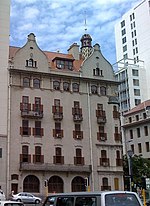Japanese Lantern Monument
Buildings and structures in Cape TownEngvarB from July 2016Harv and Sfn no-target errorsJapan–South Africa relationsMonuments and memorials in South Africa

The Japanese Lantern Monument is a symbol of political relations between the Japanese government and South Africa. This monument is currently located at the Company's Garden in Cape Town. A lantern is portable light device used as a source of light or touch like mechanism to illuminate an area of darkness. In traditional Japanese society, lanterns have been very significant in both culture and religion. In 1933, the Japanese government offered to construct a lantern monument in the Company's Garden which was handed to the Government of South Africa as a symbol of appreciation for their benevolence towards Japanese immigrants during World War I.
Excerpt from the Wikipedia article Japanese Lantern Monument (License: CC BY-SA 3.0, Authors, Images).Japanese Lantern Monument
Tuin Plein, Cape Town Cape Town Ward 115
Geographical coordinates (GPS) Address Nearby Places Show on map
Geographical coordinates (GPS)
| Latitude | Longitude |
|---|---|
| N -33.925833333333 ° | E 18.418333333333 ° |
Address
Company's Garden
Tuin Plein
8001 Cape Town, Cape Town Ward 115
Western Cape, South Africa
Open on Google Maps









